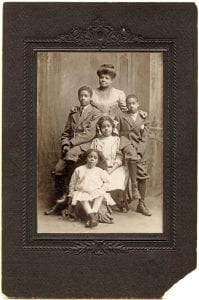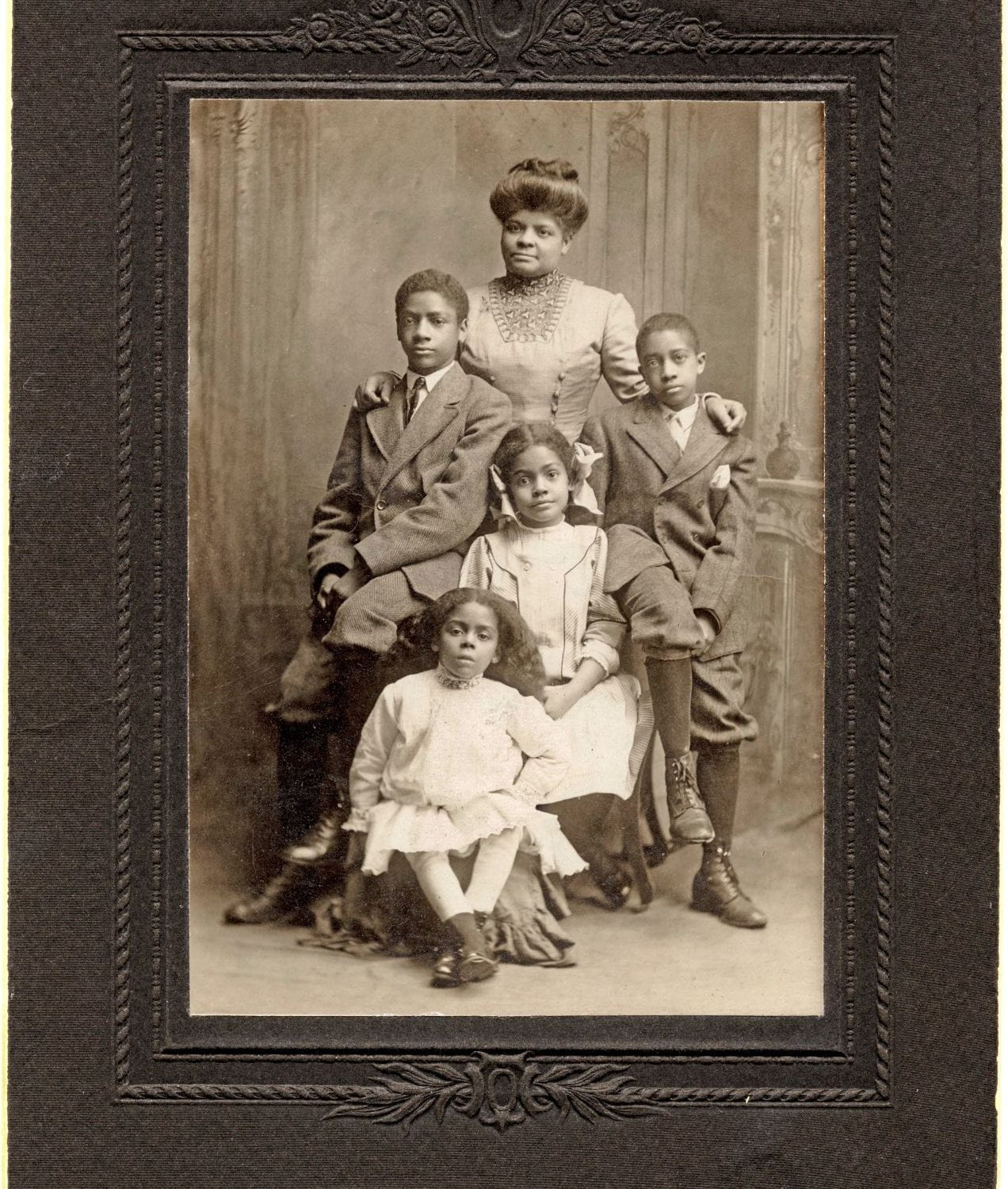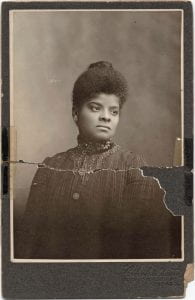Voicing Identity
Ida B. Wells was an African American civil rights leader who took advantage of the photograph’s supposed ability to tell the truth. Having been exposed to the effects of lynching photographs in newspapers, she recognized the photo’s ability to both perpetuate and destabilize racial boundaries. As with W.E.B. Du Bois’ Types of American Negroes, Georgia, U.S.A., Ida B. Wells confronts the exclusive white middle-class space with her own redefined black identity.[1] With the photo as her immediate medium, Ida contradicts what it means to be a black woman in the early twentieth century. She presents herself with a dignity and presence that gives voice to the voiceless.
In the photograph entitled Ida B. Wells-Barnett with her children (1909) (Fig. 1), Ida B. Wells sits with her four children Charles, Herman, Ida, and Alfreda.[2] The print is pasted on an embossed cabinet card that is light to the touch. Looking closely, it is also worn around the edges (Fig. 2). These details suggest it has passed through many hands over the years. The durable cabinet card was popular at the time for its larger size. It would typically be put on display in a family cabinet. First impressions include the stately appearance of Ida and her family, despite the average standard of living for African Americans in 1909. Noticeable also is the absence of a husband, especially given the rarity of established independent women with children for that time. (Ida had in fact been married to Ferdinand Barnett since 1895, but apparently did not see him as necessary to “complete” this family photo—challenging the idea that a work-life balance was impossible for the empowered female activist.)[3] Ida and her children are dressed impeccably, but maybe just for this photo: the children’s expressions don’t appear to be so comfortable. Ida B. Wells herself wears a neutral expression with a thin smile. However, with her posture, her expression suggests pride in her children. Her arms reach over them in a way that seems to encircle the entire family. She looks confidently straight ahead, dignified. The family as a whole does not appear overly happy, possibly due to the slower shutter speeds of cameras of the time. Nevertheless, these people are easy to recognize as a family. They stand closely in a loose oval formation, their clear matriarch standing at the head. Perhaps this photo served as an intimate reminder of that relationship.

Ida B. Wells took several family and solo portraits throughout her lifetime. The amount suggests an awareness of the social recognition made possible to black families through the photograph. bell hooks speaks to the self-making ability of images in “In Our Glory: Photography and Black Life”, arguing that “The walls of images in Southern black homes were sites of resistance. … These walls were a space where, in the midst of segregation, the hardship of apartheid, dehumanization could be countered.”[4] Further, in her memoir, Ida B. Wells does not describe her encounters with lynchings through firsthand experience. Rather, she is exposed to the lynchings through their circulation in newspapers and photographic media.[5] The sheer exposure of Ida’s life in photographs and writing speaks to her deliberate use of visual and written media to empower, in addition to their sentimental value alone.
By choosing to work within photographic culture, Ida B. Wells combats W.E.B. Du Bois’ “white gaze” with both an acknowledgment of the medium’s pertinence to the white middle class and its sentimental value to her own family.[6] She personally valued the photos in their ability to capture memories of loved ones with truth and immediacy. However, the photos also represent a move to find a voice in a space traditionally reserved for white society. Ida creates her own opportunity for mobility with her awareness of trends in early twentieth-century studio photography and dress. She works within the medium to express her own personal and political statements, and to redefine for herself her identity as a black woman.
_______________________________________________________________
[1] Wallace, Maurice O., and Shawn Michelle Smith, eds. Pictures and Progress: Early Photography and the Making of African American Identity. (Durham: Duke University Press, 2012): 276.
[2] Wikipedia contributors, “Ida B. Wells,” Wikipedia, The Free Encyclopedia, https://en.wikipedia.org/wiki/Ida_B._Wells (accessed January 29, 2020).
[3] Ida B. Wells and Alfreda Duster, Crusade for Justice : The Autobiography of Ida B. Wells. Negro American Biographies and Autobiographies. (Chicago, Illinois: University of Chicago Press, 1970): 241–242. http://search.ebscohost.com.proxy.uchicago.edu/login.aspx?direct=true&db=nlebk&AN=698250&site=ehost-live&scope=site.
[4] bell hooks, “In Our Glory: Photography and Black Life.” In Art on My Mind: Visual Politics. (New York: The New Press, 1995): 59.
[5] Ida B. Wells and Alfreda Duster, Crusade for Justice : The Autobiography of Ida B. Wells. Negro American Biographies and Autobiographies. (Chicago, Illinois: University of Chicago Press, 1970): 138. http://search.ebscohost.com.proxy.uchicago.edu/login.aspx?direct=true&db=nlebk&AN=698250&site=ehost-live&scope=site.
[6] Wallace, Maurice O., and Shawn Michelle Smith, eds. Pictures and Progress: Early Photography and the Making of African American Identity. (Durham: Duke University Press, 2012): 274.




